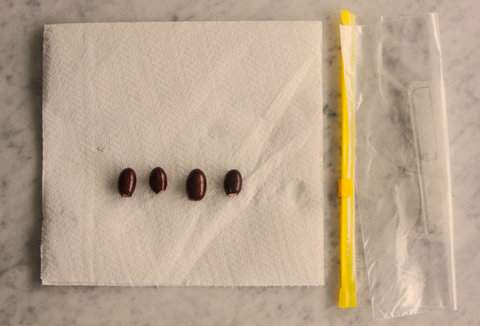Peel your eyes away from the screen and get your hands into the soil!
This guide will teach you how to germinate almost any seed, pit or bean - from avocado stones to peach pits to kidney beans.
Although getting a plant to produce fruit is a lengthy process, the early weeks of germination are immediately rewarding - seriously, you'll be surprised at how much joy sprouts can bring!
As Sue Stuart-Smith explores in her recent book The Well-Gardened Mind, humans have been cultivating for pleasure for as long (if not longer) than they have for necessity. We are hard-wired to find interacting with nature calming. In the current climate, simple gardening activities can help us feel grounded and at peace.
Sprouting seeds is a great activity to do with kids, but it's also hugely rewarding for adults. Part of the pleasure is that you never know which sprouts are going to take root, but you can give yourself the best chance by investing in our top quality mix of unusual seeds, beans and pits.
You can sow some seeds directly into soil to great success, but this blog focuses on water germination, which can either be used as a preliminary step before planting in soil, or the final step in the process.

What does germinate actually mean?
Germination simply refers to the process of growing a plant from a seed or spore.
Plenty of stones and seeds are actually really easy to sprout at home, with no special equipment or expertise required. The journey from seed to fruit production is long (and not guaranteed), but you can see seeds sprout roots and shoots in a matter of days.
When should you germinate seeds?
You can germinate seeds all year round, as long as you adhere to the requirements of the plant you're trying to cultivate. Some seeds sprout in the cold; others in warmth.
However, for the vast majority, Spring is the best time to move your seeds on from sprouting seed to fully fledged plant!

How to sprout seeds, beans and pits
TIP: For your best chance of success, try sprouting a few seeds at once (sometimes, seeds just don’t sprout, you have to roll with nature!).
You will need:
1. The seeds, nuts, stone or pit you want to sprout.
2. A small sealable plastic bag (eg. a freezer bag or the ziplock bags you get at airports!).
3. Kitchen roll.
4. A glass, a jar or a cup (see photos below).
5. Skewers or tooth pics.
6. Cling film.
Step 1
Place your seeds in the middle of the paper towel, fold in quarters so that your seeds are neatly tucked inside, then place inside your plastic bag.
Step 2
Very lightly moisten your paper towel (so its lightly damp but not dripping or tearing).

Step 3
Close your bag and place it in gently warm spot.
TIP: write the date on the bag so you can keep track of its progress - this is especially important if you get the bug and want to plant more and more seeds!
Germination time depends on the seed and can take between 2 days (beans) and a month (avocado pits).

Step 4
When you see the first little roots coming out your seeds, you’ll know it’s time to place it in water.
Take your cup and fill it almost all the way with water, so your germinated seed, bean or pit can sit on top and draw water in through its new root.
Stretch some cling film over the top and make a tiny incision in the centre, so that your seed can sit just just above the water, but the roots can grow below.
TIP: For bigger seeds, such as avocado stones, you may need toothpicks or skewers to keep the stone at the top of the glass. If you don't have, or choose not to use cling film for environmental reasons, this is also a good option to consider.
To see what you should be aiming for, check out this video from friend of Bloombox Club, botanopia (previously Sprout):
From time to time, Bloombox Club sells a beautiful selection of seeds, stones and beans. Check out our New In Accessories to see if we have any in stock!
Share your progress with us by tagging @BloomboxClub on Instagram. Customers are invited to do so in our brand new facebook group.

























